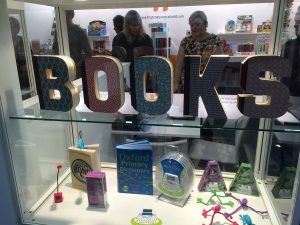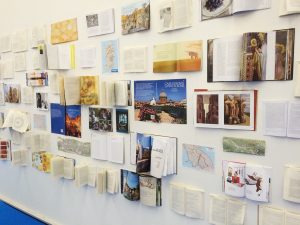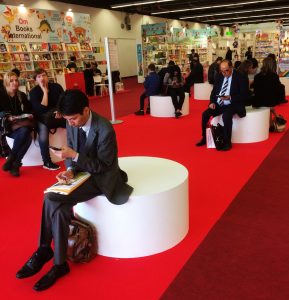A book has to be the axe for the frozen lake in us. – Franz Kafka
Once the world’s leading book event, Frankfurt Book Fair (FBF) at its 70th edition has become the most comprehensive trade platform for the cultural industry in its largest imaginable sense. This way, Frankfurt has not only been able to keep its annual attendance numbers relatively stable, but has adapted itself to a world in which book publishing categories have become broader content categories, delivered on multiple media. The licenses being traded here nowadays may for a large part still be based on written and printed manuscripts, and most of the exhibitors continue to present their books at FBF, but business at this fair increasingly includes internet and smartphone publishing rights, audiovisual and film rights, licenses for audio books, video games, maps, merchandising and various cross-media applications, most recently even augmented reality and artificial intelligence productions.
In the non-fiction content categories, two stood out at this year’s fair: The Trump Phenomenon, and the 50th anniversary of the magical 1968. Released one month prior to the Frankfurt Book Fair, Bob Woodward’s Fear, Trump in the White House appeared to be the best-selling book of the year, both in print and audio. Its publisher, Simon & Schuster, reported difficulties to keep up with demand, and foreign rights sales reached more than 30 territories during the fair. Trump’s tribulations and the rebellious Sixties were the profitable subjects of numerous titles discussed across the fair. The other major categories were educational, children’s, audio books, comics, graphic novels, movie series, and video games, practically all correlated by their respective merchandising supplements such as mugs, bags, toys, board games, calendars and what-have-you.

Total exhibitor numbers have been slightly down this year, but participation from the Asia-Pacific remained on the increase. Close to 10% of the exhibition stands, more than 600, was taken by companies from the Asia-Pacific, including 200 from China and Hong Kong, 78 from India, 55 from Australia and New Zealand, 49 from South Korea, 40 from Japan, 34 from Malaysia, as well as non-neglectable clusters from Taiwan, Thailand, the Philippines, Singapore, Indonesia, Pakistan, Vietnam, Bangladesh, Afghanistan, and Nepal. The Japan Book Publishers Association and the Egypt Publishers Association had the largest collective stands they ever occupied at FBF. The Indian scene has been on the increase as well, with 59 publishers and distributors, 3 literary agencies, 5 printing houses, and 11 software, prepress and premedia service providers.
Occupation of the rights tables at LitAg, the Literary Agents & Scouts Centre for international rights and licences trading, has been up as well. According to LitAg in-charge Riky Stock, “The number of tables rented per agency increases from year to year. The agencies are bringing more personnel – rights managers and literary agents – to Frankfurt so they can make a larger number of appointments. This great demand shows that nothing can replace face-to-face meetings in the rights and licensing business.” Traditionally, the LitAg area is made available one day before the fair, and in 2016, this area was extended with a Publishers Rights Corner, a workplace for rights managers making it easier to make appointments with counterparts. The Business Club, established three years ago, has become an exclusive workplace as well, including organized business breakfasts, happy hours and matchmaking events. Its entrance tickets also provide free access to the fair’s conferences.

One of the new features at the fair this year has been the ASEAN Forum, a dedicated space with daily presentations and panel discussions focused on each of the Southeast Asian markets. The main topics at these events were academic and kids content, translation funding programs, and the specifics of rights trading in this part of the world. Another new space, promoted under the catch line ‘Lettres d’Afrique, changing the narrative’, emerged in a collaboration with the African Publishers Network APNET, bringing together publishing houses and collective stands from 19 African countries, accompanied by a program of presentations on the African book market. New focal topic areas were ‘Frankfurt Kids’ and ‘Frankfurt EDU’, in order to pay more attention to the children’s and educational sectors, previously spread across the fair.
Another feature was the introduction of the Frankfurt Pavilion, an eye-catching 7-meter high wooden structure spanning 500 square meters in the middle of the open-air Agora space between the halls. Illuminated by natural daylight through a translucent membrane, and with seating for 300 people, the place was filled with round-the-clock panel discussions, book readings and poetry slams, while this year’s Bookfest also started out in this hall.
FBF’s conference program also continues to be expanded. The first Artificial Intelligence Conference dealt with possible opportunities this new area holds for the creative industries in terms of design, translation, sales and marketing. At the first Audiobook Conference, the Asian, Arab, Russian and US audio book markets were highlighted. At this year’s ‘The Markets’ Conference, different revenue models, such as bundled content, subscriptions and direct-to-consumer sales, were discussed. From India, Shobha Viswanath, co-founder and publishing director of Karadi Tales, held a presentation on the company’s audio books for children. Rights and licence trading was the main topic at the Frankfurt Rights Meeting, whereas the Innovation Summit brought together participants from business, culture, technology and politics to discuss technological innovation and the innovation gaps existing between their respective fields of work.

In the framework of the Arts+ Programme, it was the first time that the Frankfurt Book Fair Film Awards were distributed. They went to three film directors in the categories Best Illustrated Book on Film, Best International Adaptation for Children or Young Adults, and Best International Literary Adaptation. In addition, there was a ‘special recognition’ for the Netflix cartoon series ‘Hilda’. The Arts+ Programme also introduced a series of three two-hour ‘micro conferences’. The first one, ‘Cultural Trailblazers’, looked into the ways new technologies are changing cultural institutions, the second one discussed hybrid products, while the third one looked at interactive technologies and the opportunities they may create for the trade, distribution, presentation and reception of cultural products.
For the third year in a row, Arts+ organized the networking day ‘A Book Is a Film Is a Game’ with panel discussions, pitching sessions, workshops, networking and matchmaking sessions for film and games producers, literary agents, and rights managers.
At Weltempfang, the fair’s Centre for Politics, Literature and Translation, another forty or so panel discussions were organized on human rights, political communication, antidemocratic tendencies, and the role of the cultural industries “at the intersection of power and morality”.
The next FBF will take place from 16 to 20 October 2019. Norway will be the focal content industry. LitAg will move from Hall 6.3 and will be located at the ‘Festhalle’, a historic hall next to the fair’s City entrance. In 2020, when Canada will be the Guest of Honour, a new Hall 1 will be added, directly connected to the Agora, the Forum and Hall 3, with a new glass front facing the city. The new setting is designed for special interest formats targetted at the general public on the weekends. At the same time, international exhibitors will be shifted to Hall 4, while Hall 5 will be taken down, to be entirely rebuilt by 2023.
















